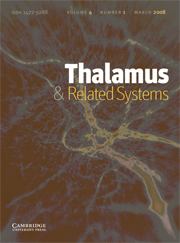Article contents
Corticothalamic operations through prevalent inhibition of thalamocortical neurons
Published online by Cambridge University Press: 12 April 2006
Abstract
Data based on dual intracellular recordings from neocortical and thalamic neurons in anesthetized cats are presented to support the assumption that bisynaptic inhibition of thalamocortical (TC) neurons, induced by synchronous cortical volleys through a prior synaptic relay in GABAergic thalamic reticular (RE) neurons, may overcome the direct excitation of TC neurons. This effect occurs during cortical augmenting responses mimicking sleep spindles as well as during the self-sustained, post-augmenting activity. Although TC volleys directly produce cortical potentials, the cortex uses its own machinery to elaborate oscillatory responses that outlast thalamic stimuli, whereas, simultaneously, TC neurons remain under a prolonged hyperpolarization arising in RE neurons. This pattern suggests that, during slow-wave sleep, when TC neurons are unable to process faithfully fast recurring signals from the external world because of their inhibition, intracortical activity may underlie processes accounting for some forms of mental activity. Opposite activity patterns in cortical and TC neurons are also observed during spike-wave seizures, which are generated in cortex and are associated with steady inhibition in a majority of TC neurons. The inability of TC neurons to transfer signals from the outside world during spike-wave seizures may account for unconsciousness during absence (petit-mal) seizures.
Information
- Type
- Research Article
- Information
- Copyright
- 2001 Elsevier Science Ltd
- 10
- Cited by

